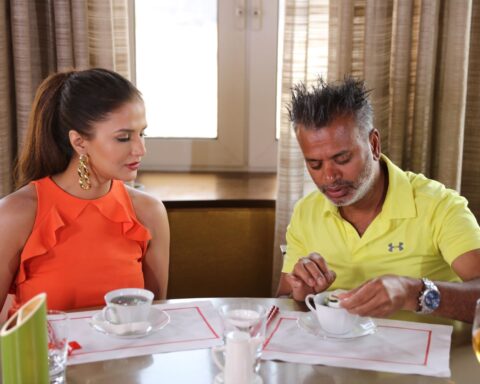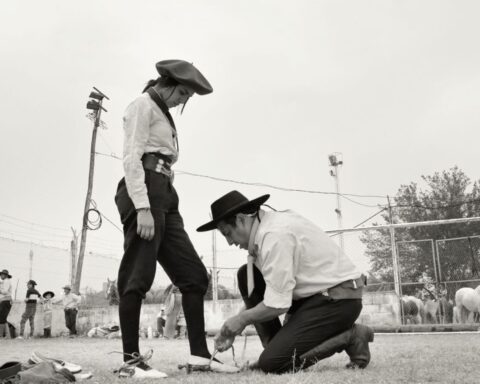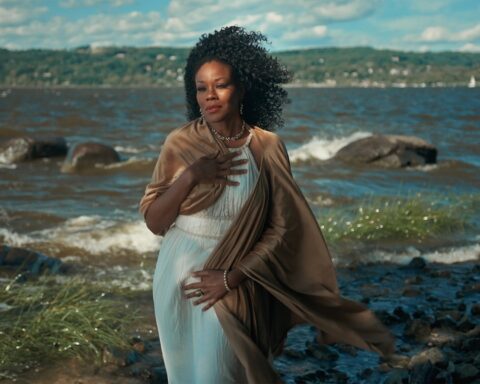Yung Chang seems resigned to certain facts regarding his latest film. “This is an event film,” he says, sitting in an editing suite of the offices of EyeSteelFilm in Montreal’s Little Italy neighbourhood. “When we release it, we’re going to have to have fruit parties at the premieres.”
Chang, now 35, has had considerable success with his first two documentary features, Up the Yangtze (2007), which chronicled the lives of several Chinese people and how they were being impacted by the damming of the Yangtze River, and China Heavyweight (2012), about a Chinese man competing to be a pro boxer.
But as he puts the finishing touches on the final cut of his latest film, he concedes that The Fruit Hunters —based on the award-winning Adam Gollner book of the same name—presented a whole new set of challenges in terms of his filmmaking process. “This definitely felt like I was stepping away from my comfort zone,” Chang says, eyes bright with enthusiasm for the project. “That was a big part of the fun of it.”
At approximately 90 minutes—Chang says he agrees with Michael Moore, who believes that documentaries should generally not exceed that running length— The Fruit Hunters tells the stories of various species of exotic fruit through the people who are obsessed with them. Chang hosts us on his international journey (an EyeSteelFilm/NFB coproduction) in which we meet up with a broad spectrum of fruit enthusiasts, from natives in the South American rainforest to Hollywood citizens (including acclaimed actor Bill Pullman) as they attempt to establish a self-sufficient Hollywood Orchard adjacent to the famous Hollywood sign. The stunning cinematography by Mark Ellam captures the fruit, and the trees and bushes that spawn them, in a way that’s hypnotic. Even if you walk into a screening after a full meal, you’re going to leave hungry. Prepare to salivate.
The most obvious challenge came with a word filmmakers usually dread: adaptation. Goliner’s book received widespread critical acclaim when it arrived in 2007, including a critical shout-out from the mighty New York Times. It also seemed like one of those books, with its attention to intricate detail and sprawling, multi-character network narrative, which was unfilmable.
But Chang loved the book. “Adam and I are friends, and he was finishing up the book at around the same time I was finishing Up the Yangtze. He gave me an advance copy, and it struck me how packed with information it is. Essentially, you could take any paragraph from that book and make it into a feature film. It’s such a lovely book. It’s full of this notion of biophilia: the love of life. Every line in the book is so passionate, there were a lot of different directions you could take it in.”
The book manages to explore the different kinds of fruit through the characters who champion them and love them so seriously. “The book is about the idea of people obsessed with fruit. There’s something so sensuous about it—it’s about orchids and flowers, an ecosystem. Adam told the story through these hunters, these individuals who have become obsessed. I liked the idea of doing a celebratory film—the book had such a sense of fun and adventure about it. Up the Yangtze and China Heavyweight are very much verité films. I felt that The Fruit Hunters would be a relief, in a way. I thought it’d be fun to taste life a bit.”
Chang faced that moment all screenwriters or filmmakers do when confronted with adaptation: He respectfully walked away from the source material. “I read the book once or twice and then put it away. What was useful about the book was to use it as a research tool. The people in the book were starting points. I spent a year travelling around Hawaii and Florida, starting to meet the hunters. They are unique people, and a lot of them are so immersed in their world that it’s hard for them to be the kind of [singular] character to carry us through the film. We needed characters who were nourished by the fruit, not just obsessed.”
In Up the Yangtze, Chang says he “built up information in a way that would still build a narrative and a personal story. The information around the different fruit hunters would lead to the notions we were talking about, and all seeking out: What is paradise?”
At this point, Chang brought on screenwriter and filmmaker Mark Slutsky to help with the writing process, which involved weeding out parts of the book and building on novel aspects. “Adam’s book is a brilliant cornucopia of characters, images and ideas,” says Slutsky. “There was no possible way to fit all of it into a 90-minute movie. Our challenge was to choose what was the most cinematic and the most representative material from the book and weave it all together in a narratively coherent way. We did add some new stuff but we were committed to staying true to what we loved about Adam’s book, its sense of intellectual adventure and ecstatic discovery.”
Unlike Chang’s two previous films, which were China-focused and -based, The Fruit Hunters meant the filmmaker was very much an outsider. “The decision not to make another China film was an important one. Older white males largely dominate the fruit milieu. It’s been interesting to discover something outside of my world.”
That journey led Chang to his own realisation: that he had an inner fruit hunter, and a hugely passionate one at that. The inner conflict led to something of an identity crisis as he continued to research and film his subjects. “At times I didn’t know if I was making a film or falling into this obsession with fruit—falling down the rabbit hole, as one person Adam interviewed put it. It was inevitable. When I would [want to] stop shooting, it was as if I couldn’t stop, because I had to go on. There was so much fruit we couldn’t fit into the film!”
Chang points to one of the central ideas in the film, “the notion that we are all seduced by fruit. There’s a powerful connection between the fruit and the fruit hunter. If you think about a head of lettuce or broccoli, you don’t really get turned on by it. But I think fruit really does something to you. That sense of sweetness, captured momentarily, and then you’re chasing that moment. The story behind the fruit, the early memory of it, everyone has a moment like that. For me I think it came when I visited my grandparents in Taiwan and ate durian for the first time.”
The Fruit Hunters doesn’t have one obvious hook running through it. Instead, the film unfolds with multiple sensory orgasms. Each fruit discovery leaves us wondering what, precisely, such a find will taste like. At one point we see someone peeling what is known as citrus caviar, or Australian finger limes— wonderful, one suspects.
It makes for tasty viewing, but it also prompts questions about Chang’s creative process, given his previous two features. After all, Up the Yangtze offered an immediate and obvious built-in metaphor. The damming of the Yangtze River reflected the massive changes of the new economic powerhouse of China, as told through the eyes of wealthy tourists and young, impoverished Chinese workers. China Heavyweight, meanwhile, focused on boxing—an extremely cinematic sport, proven to be both photogenic and dramatic in films like Raging Bull and Million Dollar Baby.
Where is the obvious overriding metaphor in The Fruit Hunters? Did Chang feel like he was filmmaking without a safety net? “In many ways, this film allowed me to break out of the mould, which was part of the challenge. To me, the experience was sort of like making a comedy.”
A comedy? “Sure. The experience was enlightening to me, because it encouraged the idea that there was something to live for—to delight in these seemingly mundane objects. Thematically, it’s hard to make the link between the three films, but the idea was to make the film about the fruit hunters and their quests, rather than the fruit itself. So not so much about the crazy fruit but the people who are so enthralled by it.”
And dreaming outside of his previous creative paths meant Chang felt freer to experiment. There are dramatic sequences in the film, which show us historic moments in fruit history. And Chang even gets to throw in a magical fantasy sequence, in which actor Bill Pullman yanks specially designed animated, glowing fruit from a vine.
“A lot of the narrative arcs became clearer during the editing process, as so often happens. So many options came to light then. I loved the filmmaking process, where I could just suddenly say, ‘Hey, there’s a dream sequence here, with Bill—let’s do it!’ The fruit connects to our imaginations, in so many ways. And to our creativity. Trying all these magical fruits, going down the yogic road of imagination, to explore the historical connections of fruits. Let’s just make this as idiosyncratic as possible. We built all these miniature sets to include in the film, which became a parallel obsession. We built a ton of them.”
The dramatic re-enactments and fantasy elements made The Fruit Hunters “very freeing to me,” says Chang. “To have this fictional thing going on—to know that, walking into a film, you’re building your own sensibility, and you can think about the film’s structure during development. For this film, the walking-in part allowed me to feel far more improvisational.
“Yes, it can be a nightmare, but it’s finding the links—that’s what’s great about documentary. You don’t have to build narrative the way you do with dramatic films, you can create these tangential, thematic links. That’s what’s fun about it.”
Chang says his own search to realise who would provide The Fruit Hunters’ brief narration also led to clarity of structure and perspective. “For a time, we thought we’d have Bill [Pullman] do the voice-over. With Adam’s book, he originally had none of his own voice in it. Then he found, with the feedback of some of his editors, that his voice provided a way to connect things. We found that too. Obviously, we didn’t want the voice-over to be too empirical, to guide the audience to certain conclusions. But it provides a personal through-line.”
Structure aside, Chang’s clear passion for the tastes he encountered while making The Fruit Hunters raises one central question about how the film will ultimately be received. As the renowned British film magazine Sight & Sound’s name suggests, there are two senses that are central to the film-going experience. Capturing the other senses has proven tricky. In 1974, Hollywood released the cheeseball epic disaster movie Earthquake, boasting the film had been shot in Sensurround. This meant each cinema wheeled in giant speakers that blasted a static-sounding noise during the earthquake sequences in the film, making the seats vibrate. John Waters even parodied the extra-sensory cinema experience with his 1981 film Polyester, in which audience members were handed scratch-and-sniff cards, allowing them to smell along with the action. (Waters was riffing on the wacky antics of one of his idols, B-movie producer and exploitation master William Castle.)
“It’s funny you should bring that up, because we thought about releasing the scent of fruit into the theatre as people are watching the film. What came to light for me is, when you see someone eating something, you can imagine the taste. I was worried that people wouldn’t be able to sense the taste, but I think that comes through.”
Chang lends the sensuousness a certain erotic power too, noting in voice-over some of the sexual overtones of the gushing, flowing, juicy fruit as it’s handled by those about to eat it. Despite the intentional fun and sensory overload of it all, any film that involves the environment can’t be entirely upbeat. The Fruit Hunters points to factory-farming practices like monoculturalism, which privileges fostering one species of fruit over many others, to maximize storage and marketing possibilities. These policies have far-reaching, deleterious consequences for the environment, and also strictly limit the types of fruit we can access at our local supermarkets.
“But you know, I don’t think I’m much of a pessimist. I’m very optimistic,” he says. “The previous two films, things always seemed to go down that dark path. I wanted a different kind of gratification for this process.”
It was a tricky balancing act for Chang and The Fruit Hunters, given the state of agriculture in the early 21st century. “One of the most powerful moments in the film comes when I visit with a fellow from a nomadic tribe in Borneo. They are being assimilated and pushed out of the forest by the government. One official even told them that he’d rather they be eating McDonalds than the unmentionables they find in the forest. He actually said that!
“For me it was a revelation to walk around with this individual [from Borneo] who took us through a patch of the rain forest and showed us several different kinds of fruit. To see that they could live off of these fruits was amazing. To bring the film back to that very first moment—to pick fresh fruit off a wild tree—that’s what I was feeling at that moment.
“Yes, it’s disheartening to see this threat of destruction and development, and this notion of monoculturalism sweeping through our markets. There’s diversity in our backyards that people seem to avoid. I hope this film will open people’s eyes to that. You know, in my neighbour’s yard in Montreal, they have ground cherries. They’re totally delicious! And they are easy to grow if you have a yard. I hope the film encourages people to grow unusual fruit on their own.
“I want watching the film to be a lush experience. I mean, it’s fruit on film! I want people to feel like they can be happy.”











